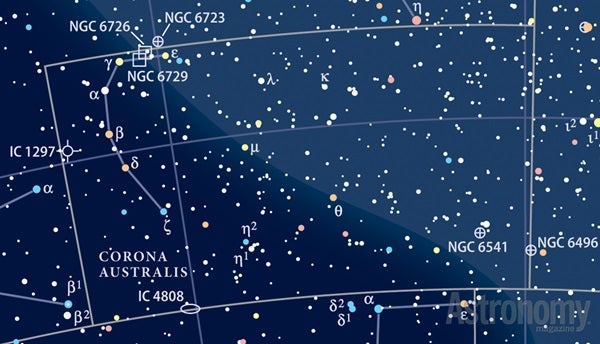Targets for September 4–11, 2014
Naked eye and Binoculars: Corona Australis
Small telescope: The Castaway Cluster (NGC 6520)
Large telescope: The Red Spider Nebula (NGC 6537)
This week’s naked-eye object is the small but relatively bright constellation Corona Australis the Southern Crown. You’ll find it under the Teapot of Sagittarius and east of Scorpius’ curved tail.
Four constellations border Corona Australis: Ara the Altar, Sagittarius the Archer, Scorpius the Scorpion, and Telescopium the Telescope. The Southern Crown is not a large constellation. It covers only 128 square degrees of sky, which is about 0.3 percent. Its size ranks it a paltry 80th out of the 88 constellations in terms of area that cover the sky.
But what Corona Australis lacks in size it makes up for in brightness. It ranks as the second-brightest star pattern. Its small area contains 21 stars more luminous than magnitude 5.5.
The constellation contains no star in the lists of top 200 brightest or top 200 nearest stars. It also has no named star.
The best time of year to see this constellation is in the summer. It lies opposite the Sun’s position in the sky June 30. Conversely, the Sun lies in Corona Australis’ part of the sky around December 31, making year’s end a poor time to observe it.
Corona Australis is completely visible to anyone located south of latitude 44° north. And observers won’t spot any of it from places north of latitude 53° north.
Lonely majesty
This week’s small-telescope target is the Castaway Cluster in Sagittarius. Also known as NGC 6520, this open cluster shines at magnitude 7.6 and measures 6′ across.
You’ll find it 2.6° north-northwest of magnitude 3.0 Al Nasl (Gamma2 [γ2] Sagittarii). Through a small telescope at low power, you’ll see a well-defined cluster against a bright background of distant stars. Increase the magnification, and 30 stars of magnitudes 10 and 11 in the central one-third of the cluster come into view. At a magnification of 150x, scan the region to the west and south, and you’ll see far fewer stars. What you’re looking at is the dark nebula Barnard 86.
Astronomy magazine Contributing Editor Stephen James O’Meara calls this object the Castaway Cluster in honor of Robinson Crusoe. He gave it that name because, to him, the view around NGC 6520 is so grand that the cluster looks like some lonely, uncharted isle in a tempestuous sea.
A celestial spider
This week’s large-telescope target is the Red Spider Nebula in Sagittarius. This planetary nebula also carries the designation NGC 6537.
Our target sits 2.3° west-northwest of magnitude 3.8 Mu (μ) Sagittarii. Pull out an 11-inch or larger telescope to view this object. Even through that aperture, at any magnification below 250x, the Red Spider Nebula appears starlike. Above that limit, you’ll see a round bluish disk. An Oxygen-III filter helps bring out this nebula, but you won’t see the object’s blue color through it.
NGC 6537 is a real large-telescope target. It glows feebly at magnitude 13.0, and it’s not all that concentrated either. The planetary measures 1.5′ across.
This object’s common name comes from its appearance on long-exposure images taken through large telescopes.
Expand your observing at Astronomy.com
StarDome
Check out Astronomy.com’s interactive StarDome to see an accurate map of your sky. This tool will help you locate this week’s targets.
The Sky this Week
Get a daily digest of celestial events coming soon to a sky near you.
Observing Talk
After you listen to the podcast and try to find the objects, be sure to share your observing experience with us by leaving a comment at the blog or in the Reader Forums.











